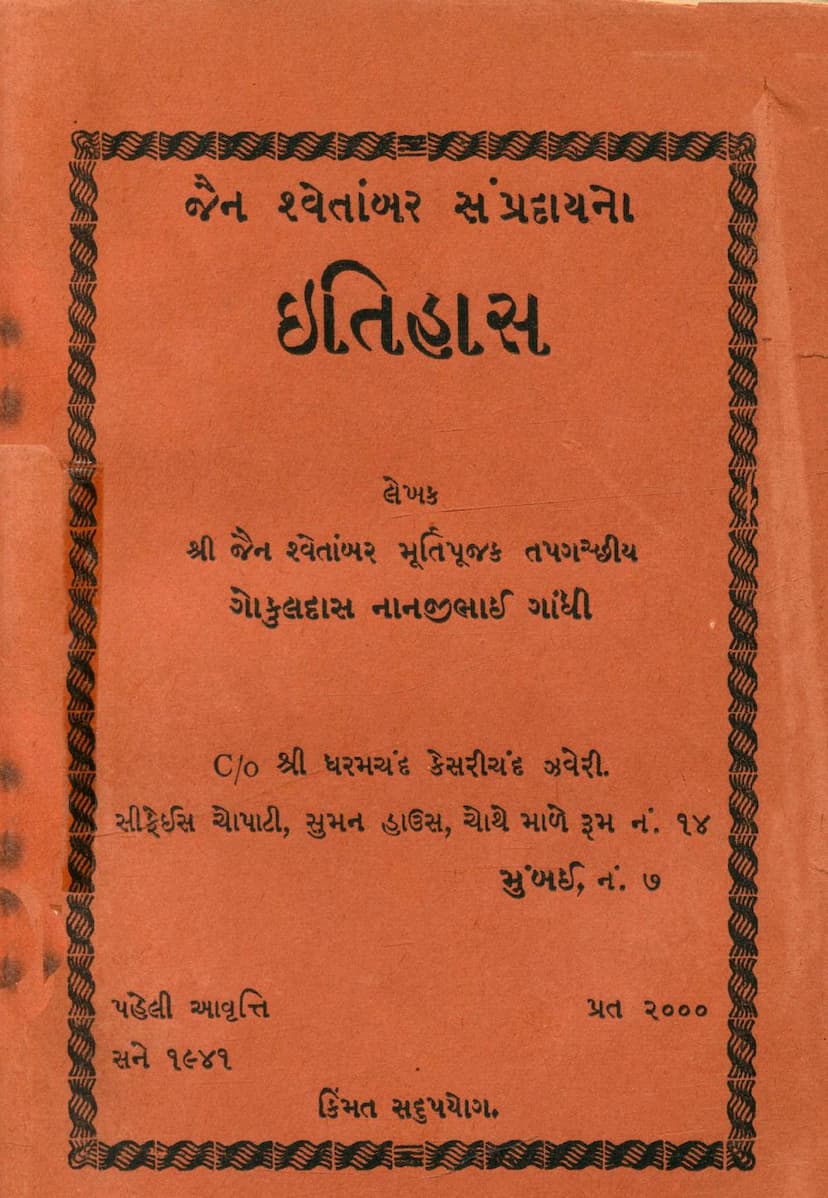Jain Shwetambar Sampradayno Itihas
Added to library: September 2, 2025

Summary
Here's a comprehensive summary of the Jain text "Jain Shwetambar Sampradayno Itihas" by Gokuldas Nanjibhai Gandhi, based on the provided pages:
Book Title: Jain Shwetambar Sampradayno Itihas (History of the Jain Shwetambar Sect) Author: Gokuldas Nanjibhai Gandhi Publisher: Gokuldas Nanjibhai Gandhi Publication Year: 1941
Overall Theme and Author's Intent: This book, authored by Gokuldas Nanjibhai Gandhi, aims to provide a historical account of the Jain Shwetambar sect. The author emphasizes the importance of a non-partisan and evidence-based approach to history, distinguishing it from mere belief or faith. He criticizes historians who write history to prove pre-existing beliefs, considering it a "murder of history." The book draws upon various historical sources such as ancient texts, inscriptions on statues, colophons of different gacchs (lineages of monks), and research by prominent Jain scholars.
Key Points and Historical Narrative:
- Ancient Jainism and its Evolution: The author starts by acknowledging the cyclical nature of Jainism with infinite Tirthankaras. He places the current era within the reign of the 24th Tirthankara, Lord Mahavir. The book traces the lineage of Jainism from Lord Mahavir through his disciples and subsequent Acharyas.
- The Importance of Pattavalis (Lineages): A central theme is the significance of the pattavalis (genealogies of monastic leaders) of different gacchs. The author considers these pattavalis to be the very history of Jainism, though he acknowledges that some might not be entirely trustworthy and require corroboration.
- Chronology and Origins:
- Scriptures vs. Idols: Gandhi argues that Jain scriptures are more ancient than Jain idols. He notes that while handwritten manuscripts are found dating back about a thousand years, and paper writing began around the 12th-13th century CE, there's a debate about the antiquity of Jain idols. He questions whether idols attributed to King Samprati were indeed made by him, suggesting they might be from an earlier period.
- Early Jain Practices: He highlights that the sadhu sanstha (monastic order) is the most ancient element, dating back to Lord Mahavir himself. The evolution of Jainism involves the development of scriptures, and later, the practice of idol worship.
- Influence of Other Religions: The author posits that the Shwetambar sect, in its current form, shows influences from Buddhism and other ancient traditions, evident in practices like processions, idol worship, and elaborate rituals. He suggests that the Digambar sect, similarly, shows influences from the Ajivika sect.
- Diversification of the Shwetambar Sect: The book details the various divisions and sub-sects within the Shwetambar tradition. These include:
- Parshvanath's Tradition: Referred to as 'Kevala Gach', 'Upkesha Gach', and 'Parshvanath Santaniya'.
- Mahavir's Tradition (via Sudharma Swami): This branch further diversified into:
- Jain Shwetambar Murtipujak Sampraday: (Idol-worshipping Shwetambars)
- Kagach:
- Dariyapuri Sampraday (founded by Dharma Singh Muni):
- Bavish Tolawali Sampraday (founded by Dharmadasji Muni):
- Shankhadaya Sampraday (founded by Lavji Swami):
- Jain Shwetambar Terapanth: The author dedicates significant attention to this sect, suggesting it emerged from a purification of Jain principles, aiming to revert to the pure teachings of Lord Mahavir, shedding external influences.
- Emergence of Terapanth: The author strongly emphasizes that the Jain Shwetambar Terapanth, founded by Swami Bhikhamji, is the most authentic representation of Lord Mahavir's original teachings, having undergone rigorous research to remove mixed influences from other religions.
- Key Historical Figures and Events:
- Early Acharyas: The text traces the lineage through important Acharyas like Jambuswami, Prabhava Swami, Shrutakhedri, Bhadrabahu Swami, Sthulibhadra, and Arya Suhasti.
- Development of Gacchs: It details the establishment of various gacchs like the Kotik Gacch (later Chand Gacch, Vanavasi Gacch), Tapagacch, Kharatar Gacch, Vadgacch,anchalgach, and Lanka Gacch. The origins and distinctions of these gacchs are explored.
- Lankagacch and its Impact: The emergence of the Lanka Gacch, founded by Lanka Mehta, is highlighted. Lanka Mehta's emphasis on pure monastic conduct and rejection of idol worship is presented as a significant reform movement against perceived laxity.
- Swami Bhikhamji and the Terapanth: A significant portion is dedicated to the life and teachings of Swami Bhikhamji, the founder of the Terapanth. His dissatisfaction with the existing monastic practices, his pursuit of pure Jain principles, and his eventual establishment of the Terapanth are described. The origin of the name "Terapanth" from a divine utterance is also mentioned.
- Other Important Figures: The book mentions the contributions of scholars like Hemchandracharya, Vastupal, Tejpal, and various other influential monks and lay followers throughout history.
- Debate on Idol Worship: The author critically examines the practice of idol worship, stating that it is not explicitly commanded in the foundational scriptures by Lord Mahavir. He suggests that the practice gained prominence later and was influenced by external factors. He also discusses the Vivaha Chulika Sutra, where Gautam Swami questions the efficacy of idol worship for spiritual progress.
- The Meaning of Jainism: The book concludes by emphasizing that true Jainism is about self-realization and the purification of the soul. It critiques practices that lead to attachment (moha-rag) rather than detachment. The author stresses the importance of understanding the distinction between pure spiritual practices (tyaga marg) and worldly indulgences (bhoga marg).
Structure and Content: The book systematically traces the history of the Shwetambar sect, detailing the succession of Acharyas, the formation of various gacchs, and key theological and practical debates that led to different schools of thought. It provides a chronological overview, referencing specific centuries and historical events to support its narrative.
Author's Perspective: Gokuldas Nanjibhai Gandhi presents himself as a seeker of truth, urging readers to approach history with an open mind and critical faculty, prioritizing evidence over blind faith. He clearly favors the Terapanth as the most authentic revival of original Jainism.
In essence, "Jain Shwetambar Sampradayno Itihas" is a scholarly yet accessible attempt to chronicle the complex history of the Shwetambar Jain tradition, emphasizing its evolution, internal divisions, and the author's perspective on the most authentic path of Jainism.